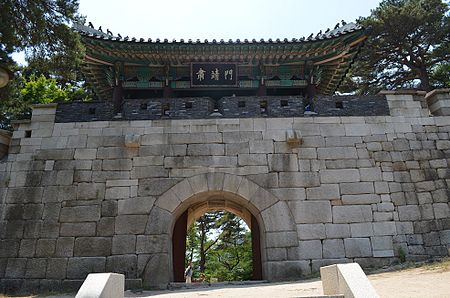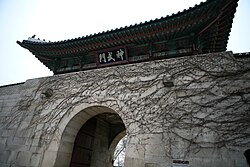Sukjeongmun
Buildings and structures completed in 1396Buildings and structures in SeoulGates in KoreaGates in South KoreaHistory of Seoul

Sukjeongmun (Korean: 숙정문; Hanja: 肅靖門; also known as North Gate) is one of the Eight Gates of Seoul in the Fortress Wall of Seoul, South Korea, which surrounded the city in the Joseon Dynasty. The gate is also known as Bukdaemun (북대문; 北大門, “North Big Gate”). It was built north of Seoul behind Gyeongbokgung Place. It was rarely used. It was only used in ceremonious and symbolic functions. In order to visit, identification such as a passport is required for access.
Excerpt from the Wikipedia article Sukjeongmun (License: CC BY-SA 3.0, Authors, Images).Sukjeongmun
Samcheong Tunnel), Seoul
Geographical coordinates (GPS) Address External links Nearby Places Show on map
Geographical coordinates (GPS)
| Latitude | Longitude |
|---|---|
| N 37.595555555556 ° | E 126.98111111111 ° |
Address
숙정문
Samcheong Tunnel)
03050 Seoul
South Korea
Open on Google Maps










